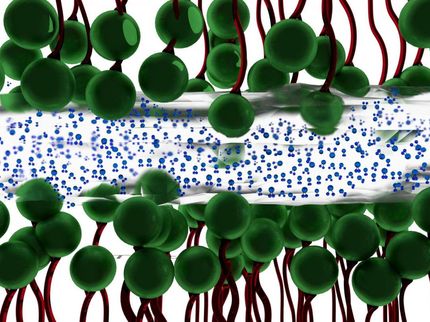Coal to Electricity
Progress toward a low-temperature coal fuel cell
Advertisement
Coal remains one of our most important sources of energy. Worldwide coal reserves are considerably larger than petroleum and natural gas deposits. If it were possible to "tease out" the energy stored in coal in a more efficient and environmentally friendly way than in conventional power plants, we could tackle one of the most pressing problems of our civilization. George M. Whitesides and his Harvard team have addressed this important problem. They have developed a model of a low-temperature coal-driven fuel cell, showing that there might be an alternative to high-temperature cells, which are under development in other laboratories.
Normally, fuels such as coal, petroleum, or natural gas are burned with oxygen from the air. This releases energy in the form of heat, which is used to generate steam. This steam expands within a turbine, producing pressure, which drives a generator (mechanical energy). The generator produces current, electrons that speed through a power line. In an electrochemical cell, the electrons can be "drawn" directly out of the chemical reaction, without burning the fuel-a much cleaner process.
Until now, most fuel cell systems have worked with hydrogen, which has to be extracted from fossil fuels, methanol, or methane. Can coal feed a fuel cell? Attempts to extract power from coal without combustion go back a long way, but have not been very successful-the electrochemical oxidation of coal is just too slow at easily attainable temperatures. High-temperature cells may be a solution, yet have to struggle with severe technical problems.
Whitesides and his team have now found a way out: some metals are able to oxidize coal very easily. The researchers made a slurry of coal powder in sulfuric acid and added iron ions with three positive charges. The iron ions react with coal to produce carbon dioxide and a reduced form of iron ions. The iron ions, which now have only two positive charges, contribute their extra electron to the electrical circuit at an electrode, the anode. The ions are then available to react again. This completes the anodic half-cell of a prototypical coal fuel cell. A soluble system based on vanadium ions served as the necessary cathodic half-cell. At 100°C this model cell delivered electricity for one thousand hours without loss of power.
Says Whitesides, "Our model cell will not be practical, but it provides evidence that coal can, in principle, be directly converted to electricity at temperatures as low as boiling water-one small step towards a practical low-temperature fuel cell."
Topics
Organizations
Other news from the department science
These products might interest you

Get the chemical industry in your inbox
By submitting this form you agree that LUMITOS AG will send you the newsletter(s) selected above by email. Your data will not be passed on to third parties. Your data will be stored and processed in accordance with our data protection regulations. LUMITOS may contact you by email for the purpose of advertising or market and opinion surveys. You can revoke your consent at any time without giving reasons to LUMITOS AG, Ernst-Augustin-Str. 2, 12489 Berlin, Germany or by e-mail at revoke@lumitos.com with effect for the future. In addition, each email contains a link to unsubscribe from the corresponding newsletter.






























































